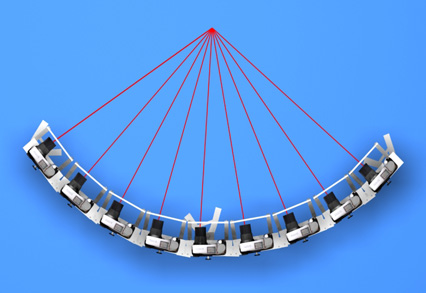

Short Summary:
The project focuses mainly on taking photographical recordings of very fast running physical processes under weightlessness ('zero G'), which are supposed to get visualized by using the 'Frozen Reality'- procedure. This allows us to 'freeze' the motion sequences and to observe them from all directions (![]() What is meant by 'Frozen Reality'?). Our team is therefore applying for a parabolic flight (
What is meant by 'Frozen Reality'?). Our team is therefore applying for a parabolic flight (![]() What is a parabolic flight?) at the 'ESA Student Parabolic Flight Campaign 2004'.
What is a parabolic flight?) at the 'ESA Student Parabolic Flight Campaign 2004'.
What exactly happens at the 'Frozen Reality' Space Project?
'What happens when small chunks of ice collide with the solar panel of a satellite? How do certain liquids behave under weightlessness?' To find solutions to these and further exciting questions concerning typical processes in space, an international team of seven students (![]() 'Frozen Space Researchers') from Germany and Italy are applying for the next 'ESA Student Parabolic Flight Campaign 2004'.
'Frozen Space Researchers') from Germany and Italy are applying for the next 'ESA Student Parabolic Flight Campaign 2004'.
The aim of the 'Frozen Reality' Space Project (FRSP) is the development and ultimately a suitability test for the visualisation procedure 'Frozen Reality' in space. It is necessary to adjust the procedure (which already works perfectly on earth) to the different conditions and demands in weightlessness. Additionally, physical investigations carried out during the experiments should demonstrate the faultless function of the equipment under 'zero G'. Furthermore, the experiment could help to obtain new information on the behaviour of ice chunks colliding with cover materials of satellites or of liquids in spaceships in weightlessness.
In addition to the basic functionality of the procedure we intend to provide and to qualify it for further uses in fundamental experiments of space research. In particular, we are aiming for the flexible use of the procedure as regards its setup, e.g. in the international space station ISS.
How does 'Frozen Reality' work in 'zero G'?
By using the 'Frozen Reality'-technique it will be possible to 'stop' extremely fast developing processes at a defined moment und to watch them as a 'frozen' state while the camera is continuously panning. During this procedure a couple of cameras, which are arranged around the experiments, record pictures simultaneously. These pictures can be added up to a three-dimensional pan shot by using a special computer program (![]() Sample).
Sample).


Picture E1: A principle picture of the adjustment of the cameras during the experiment: The experiment to be examined is photographed at the same time from different perspectives. (Source: Florian Maier)
This proceeding allows the observation of fast-running experiments and to record them with a very good local dissolution. This is a new method of visualization, which has not been possible using conventional methods.
To get an impression of the temporal dynamics of the physical procedure at the same time too, it is planned to do a high-speed recording with a special video camera in addition to the 'Frozen Reality' photographs. By combining both sets of recording technology consolidated findings about high speed procedures can be obtained. And there is an other advantage: the short time procedures are not only being scientifically examined, but this way - showing impressive pictures - these procedures can be presented comprehensibly to the laymen.